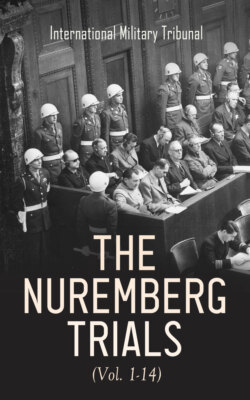Читать книгу The Nuremberg Trials (Vol. 1-14) - International Military Tribunal - Страница 170
THE REICH CABINET
ОглавлениеThe Prosecution has named as a criminal organization the Reich Cabinet (Die Reichsregierung) consisting of members of the ordinary cabinet after 30 January 1933, members of the Council of Ministers for the Defense of the Reich and members of the Secret Cabinet Council. The Tribunal is of opinion that no declaration of criminality should be made with respect to the Reich Cabinet for two reasons: (1) because it is not shown that after 1937 it ever really acted as a group or organization; (2) because the group of persons here charged is so small that members could be conveniently tried in proper cases without resort to a declaration that the Cabinet of which they were members was criminal.
As to the first reason for our decision, it is to be observed that from the time that it can be said that a conspiracy to make aggressive war existed the Reich Cabinet did not constitute a governing body, but was merely an aggregation of administrative officers subject to the absolute control of Hitler. Not a single meeting of the Reich Cabinet was held after 1937, but laws were promulgated in the name of one or more of the cabinet members. The Secret Cabinet Council never met at all. A number of the cabinet members were undoubtedly involved in the conspiracy to make aggressive war; but they were involved as individuals and there is no evidence that the Cabinet as a group or organization took any part in these crimes. It will be remembered that when Hitler disclosed his aims of criminal aggression at the Hossbach Conference, the disclosure was not made before the Cabinet and that the Cabinet was not consulted with regard to it, but, on the contrary, that it was made secretly to a small group upon whom Hitler would necessarily rely in carrying on the war. Likewise no cabinet order authorized the invasion of Poland. On the contrary, the Defendant Schacht testifies that he sought to stop the invasion by a plea to the Commander-in-Chief of the Army that Hitler’s order was in violation of the Constitution because not authorized by the Cabinet.
It does appear, however, that various laws authorizing acts which were criminal under the Charter were circulated among the members of the Reich Cabinet and issued under its authority signed by the members whose departments were concerned. This does not, however, prove that the Reich Cabinet, after 1937, ever really acted as an organization.
As to the second reason, it is clear that those members of the Reich Cabinet who have been guilty of crimes should be brought to trial; and a number of them are now on trial before the Tribunal. It is estimated that there are 48 members of the group, that eight of these are dead and 17 are now on trial, leaving only 23 at the most, as to whom the declaration could have any importance. Any others who are guilty should also be brought to trial; but nothing would be accomplished to expedite or facilitate their trials by declaring the Reich Cabinet to be a criminal organization. Where an organization with a large membership is used for such purposes, a declaration obviates the necessity of inquiring as to its criminal character in the later trial of members who are accused of participating through membership in its criminal purposes and thus saves much time and trouble. There is no such advantage in the case of a small group like the Reich Cabinet.
